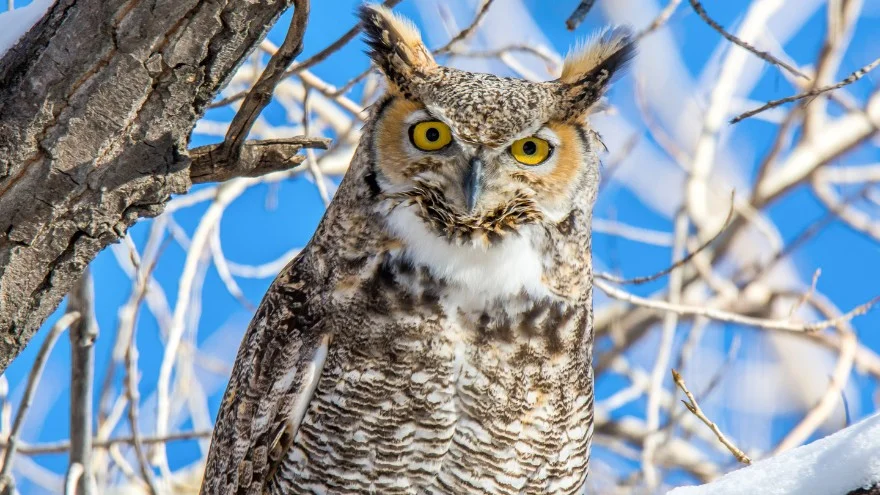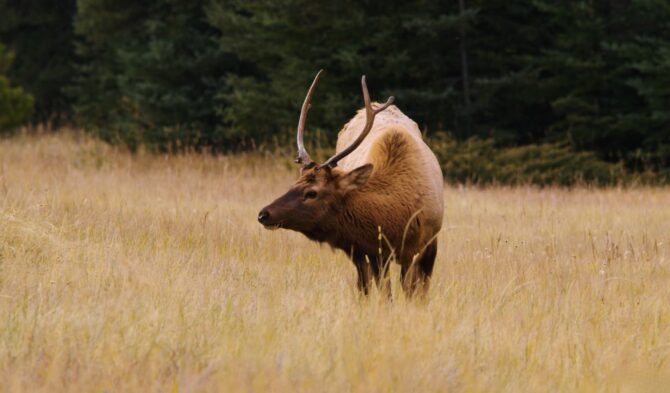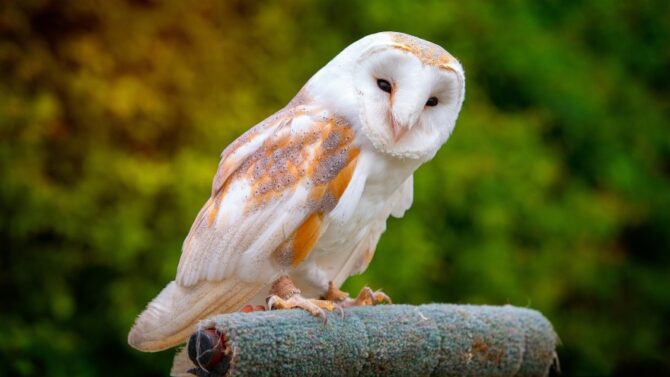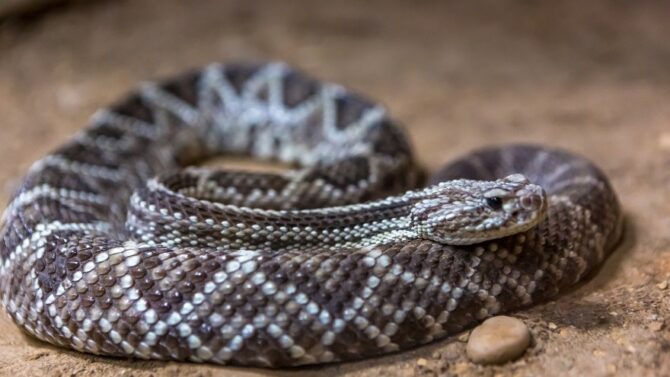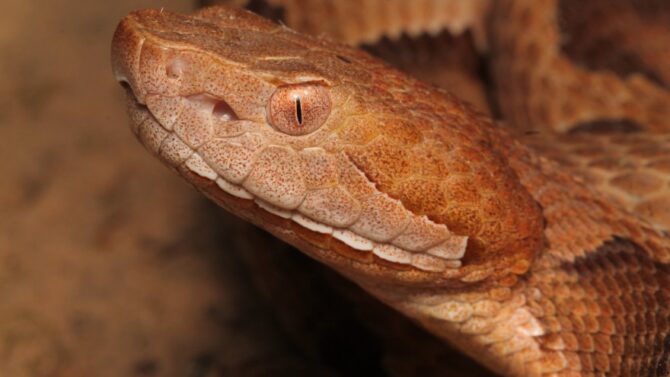Owls (Strigiformes) are grouped mainly into two families: true owls and barn owls.
The major difference between both families is that the true owl has a round facial disc with orange or yellow eyes, and the barn owl has a heart-shaped facial disc and black eyes.
You can easily tell by the eye color of an owl what time of the day it’s mostly active; yellow being day active, orange being twilight active (dawn and dusk), and black being night active. These birds stay in different places, including Oklahoma.
The different species of owls in Oklahoma include the great horned owl, short-eared owl, American barn owl, eastern screech-owl, long-eared owl, snowy owl, burrowing owl, and western screech owl.
This article will extensively discuss the nine species of owls that can be found in Oklahoma, their physical features, and how to identify them.
Species of Owls in Oklahoma
1. Great Horned Owl

- Size: 43–64cm (length), 1.6 kg in males, 1.2 kg in females (weight), and 1–153cm(wingspan)
- Colors: Mottled grey-brown
- Physical Features: Long talons, yellow-colored eyes, large tufts, and broad-winged
- Habitat: Woodland, swamps, orchards, an agricultural area, fields, wetlands, pasture, cliffs
- Scientific name: Bubi virginianus
The great horned owl is one of the biggest raptors in Oklahoma. It is also known as the horned owl due to its feather clusters rising at the top of its head like a horn.
Interestingly, the females are generally bigger than the male. They can be seen in North America, ranging from the Arctic to the tropics, and can adapt to any condition.
These owls are nocturnal animals and are most active in the twilight of the day (dawn or dusk).
Being one of the biggest (size and weight) owl species, these birds prey on large animals like; rabbits, house cats, large birds, and reptiles to carry their big bodies.
Although they are blessed with sharp eyesight and stealth-mode flying, these birds have a weak sense of smell.1
2. Barn Owl

- Size: 35–50cm (length), 330g in males, 360 g in females(weight), 68–105cm (wingspan)
- Colors: Pale brown, grey
- Physical Features: Small white face, with a brown feather, and broad-winged
- Habitat: Holes in trees, cliffs, farm sheds, church towers, meadows
- Scientific name: Tyto alba
The barn owl, commonly known as the ghost owl, is mostly found in abandoned barns. The owl has a classic heart-shaped head that amplifies its hearing.
This hearing is so excellent that they can find their prey in darkness, inside the snow, and even in thick bushes, making these nocturnal beauties the best hunters by sound in the world.
They reside permanently in Oklahoma and are loved on farms as they help reduce the rodent population.
Barn owls are nocturnal birds with dark eyes, meaning they are mostly active at night.
They have another remarkable feature: they can fly near-silent, and even a bat with its eco-location would find it difficult to sense them coming.2
During the mating season, the ghost owl does not hoot like other species; rather, they flap their wings several times in mid-flight to impress female mates.
3. Barred Owl

- Size: 40–63cm (length), 483–812 g in males, 468–774 g in females (weight), 96–125cm (wingspan)
- Colors: Grey-brown, Dull brown
- Physical Features: Dark-brown almost black eyes, gray-bodied, and broad-winged
- Habitat: Forest, wooded swamp, forest neat water bodies
- Scientific name: Strix varia
The barred owl, commonly known as the hoot owl because of its constant hooting, resides in Oklahoma.
These owls have straight strips flowing through their tail, back, and wings, which makes them camouflage with the surrounding.
Like most true owls with big dark eyes, these nocturnal predators are very active at night.
Because their feathers are very soft, these predators are almost soundless when they fly, making it easy for them to catch their prey unaware.
These owls are curious, always wanting to know and get comfortable around humans. They prefer to make a nest in evergreen or deciduous forests near water.3
These owls don’t migrate unless in search of food or shelter as they are territorial predators. Because of the healthy population of barred owls, they are frequently hunted by the great horned owl as food.
These owls are noisy and famous for the “hoo hoo hoo” sound they make constantly.
4. Eastern Screech-Owl
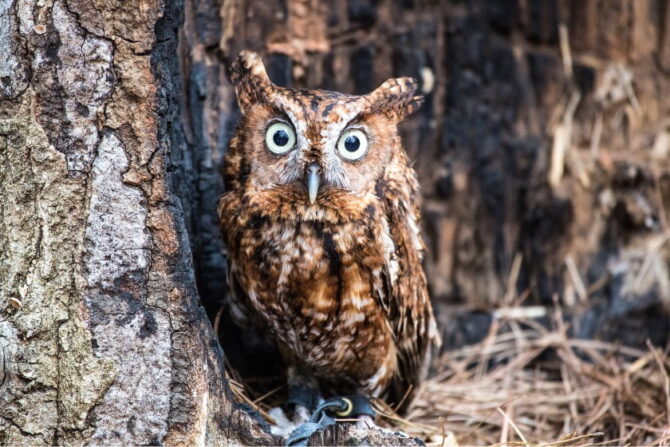
- Size: 16–25cm (length), 166g in males, 194g in females(weight), 46–61cm wingspan
- Colors: Grey morph, rufous morph
- Physical Features: Round head, yellow eyes, yellow beak, broad-winged
- Habitat: Trees, evergreen or delicious forests, wetlands, woodland
- Scientific name: Magascops asio
The Eastern Screech Owl resides in Oklahoma. They’re short and are either grey or reddish brown, with most of them being reddish brown.
They also have short, stubby ears-like tuft on their head, which they use to fend off competitors or attract mates.
They nest in forested areas and might also be found in buildings during rush hour. They try to avoid areas populated by other owls, especially those bigger than them, in order not to get killed or eaten.
These owls make different hoots; they commonly make an even-pitched chirr, often called a Quaver, which pairs use to keep in touch with one another.
The Quaver can last for about 3-6 seconds. This call sounds a lot like frogs mating. The owls are cunning and devious hunters, have a large array of diets, and apply little or no effort when hunting.
5. Short-Eared Owls

- Size: 34–43cm, 315–350 g in males, 378–411 in females (weight), and 85–110cm wingspan
- Colors: Medium Brown
- Physical Features: Yellow-orange eyes, dark rings encircling its eyes, and broad-winged
- Habitat: Meadows, grasslands, open field
- Scientific name: Asio flammeus
Short-eared owls are small tawny-brown mottled owls, mostly hunting during the daytime. These nocturnal birds are active at dusk and dawn.
Their favorite meal is vole, which is mostly their diet. To appear fearsome, they use their tuft of feathers. They have flame-colored feathering on their underwings.
They are also found in Flatlands. In Oklahoma, they are mainly seen in fields, grasslands, or airports at dusk or dawn. They build their nests on the ground.
When leaving their nest to evade a predator, they will poop on the eggs to keep predators away from them.
They might also pretend to be crippled or even leap away from their nest to bait predators away from their nest.
6. Long-Eared Owl

- Size: 31–40cm (length), 288g in males, 327g in females (weight), 86–102cm (wingspan)
- Colors: Hues of Tawny
- Physical Features: Yellow eyes, yellow facial disk, and broad-winged
- Habitat: Woodland, shrubby thickets, hedgerow, conifer trees
- Scientific name: Asio otus
Long-eared owls are known as Cat owls because of their long tuft of feathers that look like cat ears.
These owls are secretive and nocturnal. With their excellent camouflage, they are very difficult to spot.
They can hunt out in the open fields to find food without being spotted. Their favorite meal is the humble vole. However, they also hunt small rodents and birds.
Since they are very hard to see, the best way to discover them is during their mating season, as the male is quite chatty.
They repeat their call from 10 to 200 times during mating, as they are friendly owls.
Something unique about them is that they are called the parliament of owls because they live in groups, which is rare for most owls. They like roosting in areas with heavy foliage.
7. Snowy Owls

- Size: 52.5–64cm for males, 54–71cm for females (length), 1.4 kg–1.8 kg for males, 1.7 kg–2.4 kg for females (weight), and 116–165.6cm for males, 146–183cm for females (wingspan)
- Colors: White with brown or black markings
- Physical Features: Small head, bright yellow eyes, and broad-winged
- Habitat: Open area with few trees, grassland, and an open field
- Scientific name: Bubo scandiacus
These owls are one of the most mind-blowing animals; they are white, with horizontal dark lines on their bodies save their breast and face.
The males make a loud “hoo, hoo” when in search of a mate or when defending their nest.
The call is loud and can be heard up to 7 miles away. Females rarely hoot, although they make other noises like hissing, shrieks, and bill snapping.
Snowy owls are diurnal raptors. They thrive on hunting any time of the day, be it day or night. They have a very extensive diet that covers an array of food.
They even hunt larger animals like ducks, squirrels, rabbits, and rodents. They are very skilled at sensing prey from a distance.
And what separates them from other owls is their ability to dive into the snow to seize their prey.
8. Burrowing Owl

- Size: 19-20cm (length), 140-240 g in males, 147-300 g in females (weight), and 50.8-61cm(wingspan)
- Colors: Mottled brown
- Physical Features: Bright eyes, white eyebrows, and broad-winged
- Habitat: Grassland, desert
- Scientific name: Athene cunicularia
The first thing you notice about these owls is their scowl. Their feathery white eyebrows and gaze give them a very menacing look. They have brown feathers and stripes and pale-colored spots on their chest.
Unlike every other owl, these birds prefer to live underground. They dig their homes underground or sometimes take over the dugout of larger animals like the prairie dog.
Though they can make different sounds, they are not very friendly. They make two-syllable sounds like “who-who” or “coo-coo-roo,” which is also only made by males during mating and when defending their homes.
They love staying on the ground as their small body and long legs allow them to move fast when searching for food. They hunt rodents, reptiles, and rabbits.
9. Western Screech-Owls

- Size: 19–28 cm (length), 200 g in males, 208 g in females (weight), and 55–62 cm (wingspan)
- Colors: Dark brown, grey
- Physical Features: Yellow eyes, grey or dark brown leather, and broad-winged
- Habitat: Farm field, suburban
- Scientific name: Megascops kennicottii
Western Screech-Owls are found in a lot of places in Oklahoma. Their feathering is mostly bluish-gray, grey, or dark brown, and the females are larger than the males.
Regardless of their name, they don’t sound “screechy.” Their common sound is a pleasant chirr (“hoo-hoo-hoo” or “cr-r-oo-oo-oo”), which increases in pace towards the end but doesn’t change in pitch.
They have a very extensive diet and will hunt rats, mice, birds, fish, and amphibians. They also eat invertebrates like crayfish, insects, earthworms, and slugs.
These birds are opportunistic hunters. They have sometimes been caught taking a trout out of the water and have also been known to eat animals as large as a duck or rabbit.
One of their special features is coloring. They have different feather colors; some have dark brown feathers, while others have bluish-grey coloring.
Western Screech-Owls are known to nest in farm fields and suburban areas. They do not migrate and also love to stay near water bodies.
Conclusion
Owls in Oklahoma are of different sizes and colors and are a wonderful sight to behold.
They are found in abandoned barns, forests, riversides, deserts, woodlands, and different parts of the state.
These owls live peacefully amongst humans, and there have been no fatalities. They do not attack unless you encroach on their territory, young ones, or mates.
If you find yourself in Oklahoma sightseeing and come across one of these big dark-eyed beauties staring at you, don’t be alarmed because as long as you don’t bother them, they won’t bother you.
Next up…
- Are There Wolves In Oklahoma?
- 10 Most Dangerous Animals In Oklahoma (Some Are Deadly)
- Wildlife In America – Native Animals In The United States
References & Notes
- Ogden E. L. 2017. The Silent Flight of Owls, Explained. Audubon.
- Wing Feathers Enable Near-silent Flight. AskNature.
- Kids’ Inquiry of Diverse Species, Strix varia, barred owl. BioKIDS.
